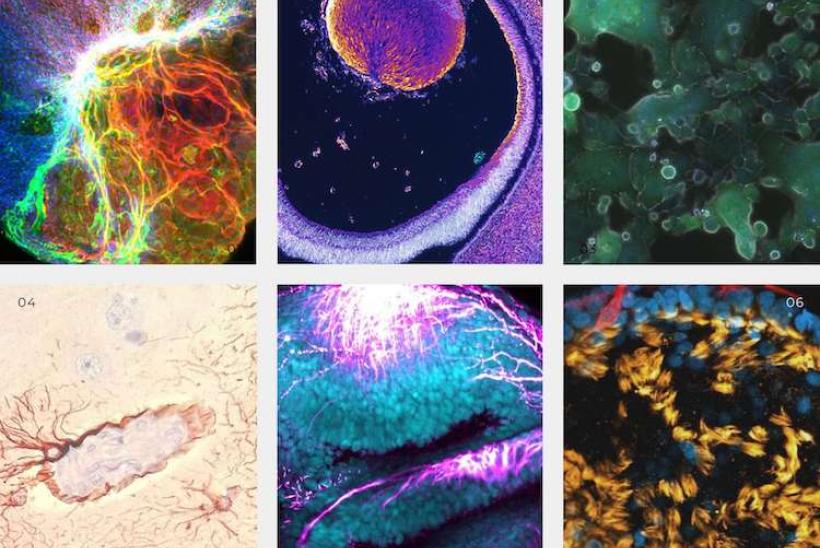A moment of discovery: extraordinary images showcase research at GOSH
A vibrant image helping researchers' study gastrointestinal diseases and their potential treatments has been crowned the winner of the 3rd annual National Institute for Health and Care Research Great Ormond Street Hospital Biomedical Research Centre (NIHR GOSH BRC) image competition ‘A Moment of Discovery’.
Staff across GOSH and its affiliated institutes, the NIHR GOSH BRC and University College London Great Ormond Street Institute of Child Health (UCL GOS ICH) were invited to submit an image that captures ‘a moment of discovery’ in their research. The competition was also opened to other children’s hospitals across the UK within the NIHR GOSH BRC paediatric Excellent Initiative, including Alder hey, Birmingham and Sheffield.
11 images and gifs displaying the variety of research connected to GOSH were shortlisted and put before three panels – the GOSH Young Peoples Advisory Group for Research (YPAG), NIHR GOSH BRC stakeholders and the GOSH staff networks. These images offer glimpses into the research being undertaken at GOSH and its partners, that helps find new treatments for rare or complex conditions and hopes to transform the lives of seriously ill children and young people.
Voting across our three panels this year was incredibly close, and three favourite images were selected. These three favourites were put to the public who voted for an overall winner via social media.
After hundreds of votes across LinkedIn and Instagram, the image crowned the winner was ‘The explosive potential of gastrointestinal organoids’ entered by Giada Benedetti.
Overall winner: The explosive potential of gastrointestinal organoids
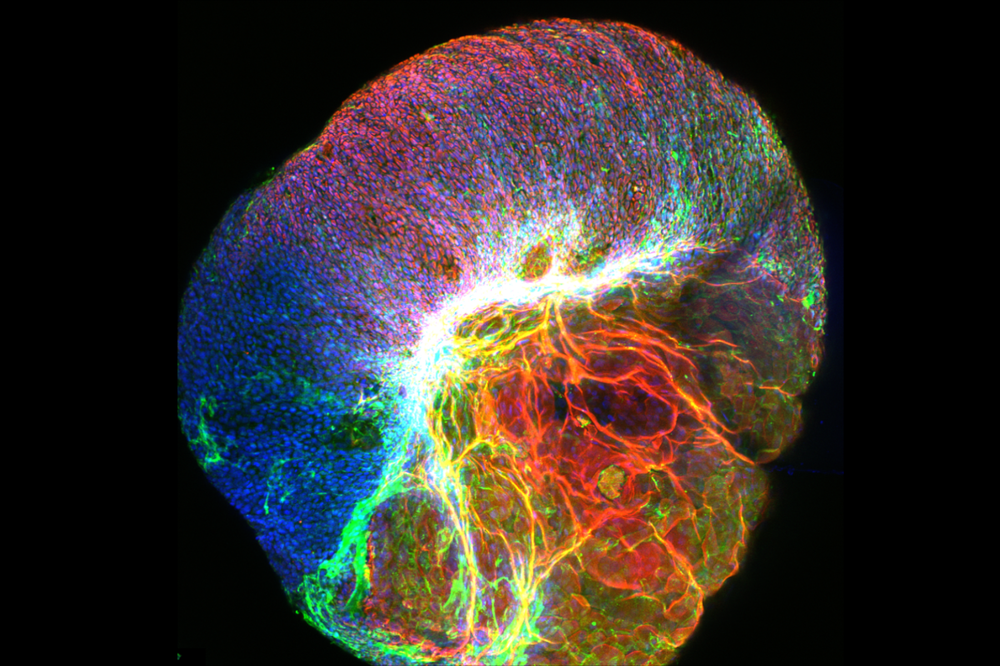
Image showing an exploding 'mini-organ' used to study gastrointestinal diseases and help find new therapies
Submitted by PhD student, Giada Benedetti, this image shows a gut ‘mini-organ’, known as an organoid, and it is a tiny copy of the digestive system. During a process used to visualise specific proteins, one of the organoids exploded, revealing its inner workings. These tiny organs are useful to model gastrointestinal diseases and are the perfect tool for scientists to study new therapies and test new drugs in the laboratory. In particular, the organoids can be derived directly from paediatric patients, and this gives us the opportunity to test therapies that specifically benefit the child.
The team behind the image
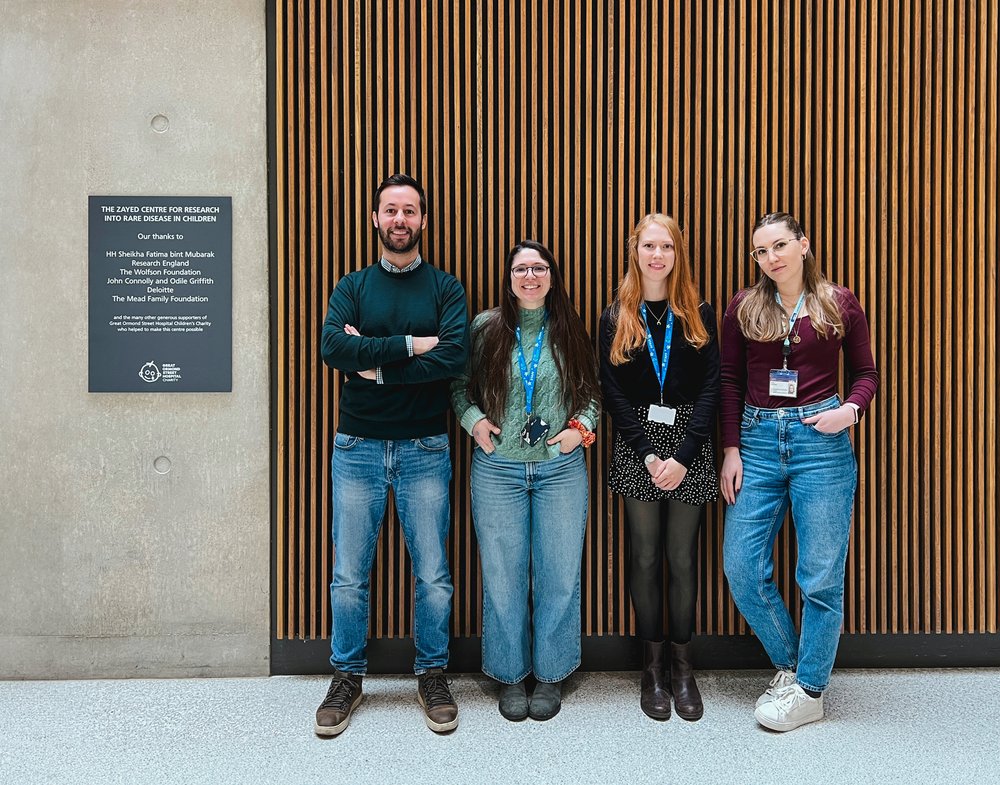
Senior research associate Giovanni Giuseppe Giobbe, Marta Gazzaneo, Lucy Holland, and Giada Benedetti.
Pictured above are some of the team who helped create the winning image. The multidisciplinary team are based at the ZCR and are using these ‘mini-organs’ called organoids to study different diseases and use them to test new therapies.
“Sometimes it can be easy to lose sight of why we are performing research, but the close Interactions with the hospital really help motivate and give a clear purpose for the work that we do in the lab”
“The image competition is an excellent way to spread awareness for the research and display our scientific findings more dynamically and artistically, which is something that is easily lost in our usual world of numbers and spreadsheets”
Giada Benedetti, Phd student and winner of this year’s image competition.
Panel favourites:
It's about seeing the world

Image showing an embryonic eye stained for dystrophin
Submitted by PhD student, Reem Alkharji, this image shows the embryonic eye. The eye contains various specialised cell types which are crucial for sensing light and transmitting visual information to the brain. As development progresses, connections between the eye and the brain also develop, creating the optic nerve. Dystrophin proteins are required for normal visual functions. This image shows the embryonic eye stained with dystrophin to visualise its location and its contribution to the developmental journey. This work aims to discover what dystrophin and its associated proteins look like in developing brain and how it changes with development.
What we kneed to know.
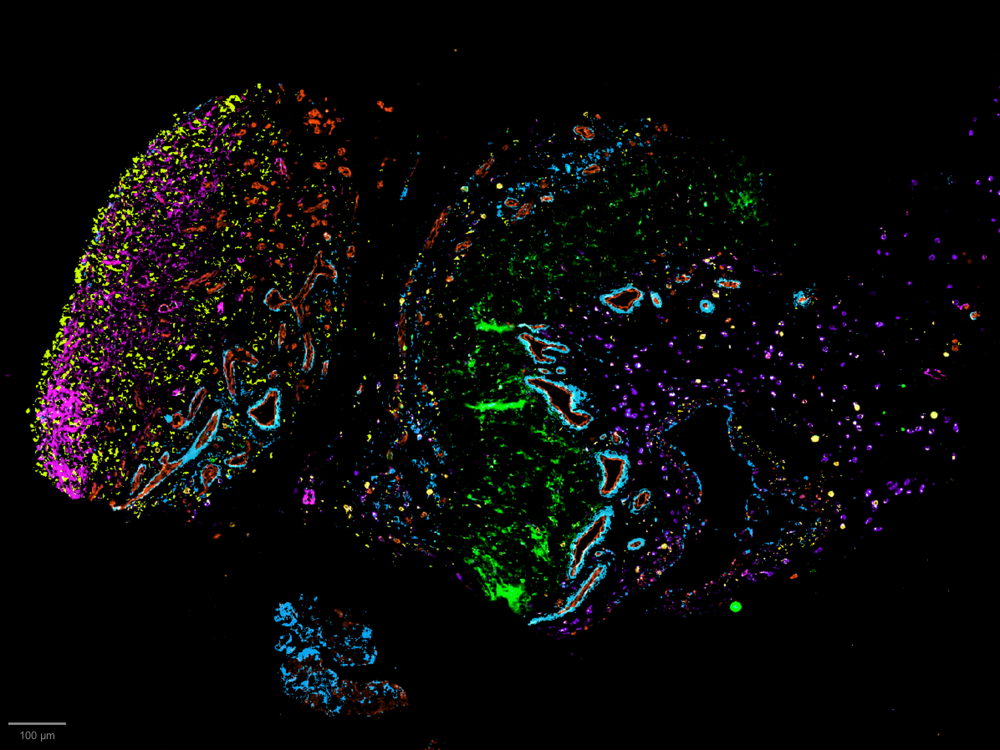
Image showing the cells in a knee joint of a child with arthritis
Submitted by PhD student Chrissy Bolton, this image shows the cells in a knee joint of a four-year-old with arthritis. The red areas show the blood vessels infiltrating the tissue. They increase as the disease progresses, bringing in cells which attack the joint. The outer yellow and pink areas should be a thin barrier for the knee but becomes thicker as the joint tries to heal the damage caused by the inflammation. The green layers show scar tissue, which makes the joint stiffer and harder to move.
In the UK, inflammatory arthritis affects 1 in 1,000 children, typically affecting the large joints. After a decade of treatment, most children still suffer from ongoing disease. Most research in arthritis has focused on adults. How chronic inflammation differs in a child's developing immune system is still poorly understood. Ultimately, it was the parents who told us that their children must also benefit from the advances in technology that has driven research forward.
-
 ‘My lung is on fire’ was entered by PhD student Giuseppe Cala. This image shows a lung ‘mini-organ’, known as an organoid, grown from stem cells.
‘My lung is on fire’ was entered by PhD student Giuseppe Cala. This image shows a lung ‘mini-organ’, known as an organoid, grown from stem cells. -
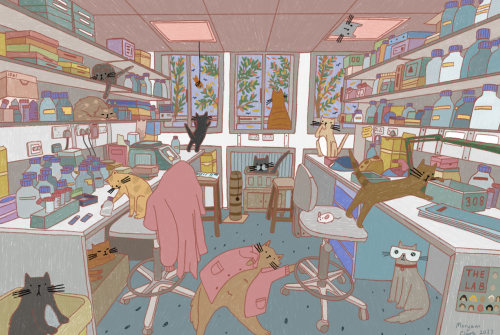 ‘Lab is home’ was entered by Post-doctoral Researcher Maryam Clark. As a researcher you spend years working in the laboratory and moments of discovery are sometimes found alone at the microscope or late in the evening. Often, we only see the output of science and we rarely get to know the journey of the people behind the discoveries and how they felt whilst making them.
‘Lab is home’ was entered by Post-doctoral Researcher Maryam Clark. As a researcher you spend years working in the laboratory and moments of discovery are sometimes found alone at the microscope or late in the evening. Often, we only see the output of science and we rarely get to know the journey of the people behind the discoveries and how they felt whilst making them. -
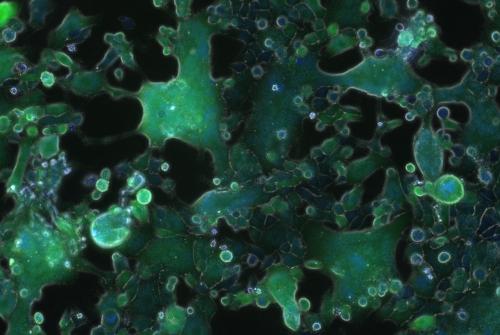 ‘Syncytial formation of respiratory syncytial virus following cell infections’ was entered by PhD student Muhammad Pradhika Mapindra. Respiratory Syncytial Virus (RSV) is a respiratory virus that can cause mild flu like symptoms, but in infants and older adults it can be more severe and lead to hospitalisation with respiratory support.
‘Syncytial formation of respiratory syncytial virus following cell infections’ was entered by PhD student Muhammad Pradhika Mapindra. Respiratory Syncytial Virus (RSV) is a respiratory virus that can cause mild flu like symptoms, but in infants and older adults it can be more severe and lead to hospitalisation with respiratory support. -
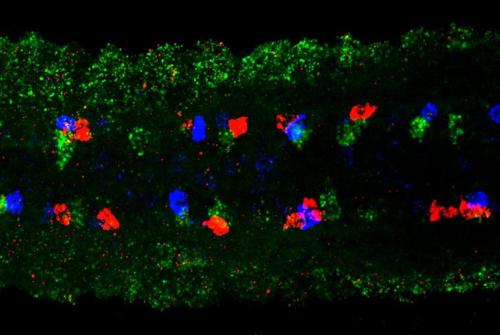 ‘The lights of life’ was entered by PhD student Atachapon Theppichaiyanond. During the development of the central nervous system (CNS), neural progenitors generate neurons by undergoing asymmetric division (cell division that generates a neuron and a neuron progenitor or two distinct neurons at the same time).
‘The lights of life’ was entered by PhD student Atachapon Theppichaiyanond. During the development of the central nervous system (CNS), neural progenitors generate neurons by undergoing asymmetric division (cell division that generates a neuron and a neuron progenitor or two distinct neurons at the same time). -
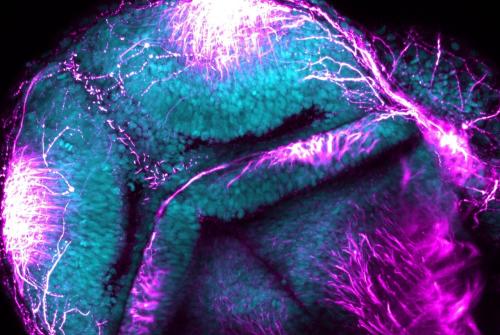 ‘Stabilised microtubules in zebrafish central nervous system’ was entered by PhD student Sara Anuar. Microtubules are tubular structures which form key components of the cytoskeleton in cells.
‘Stabilised microtubules in zebrafish central nervous system’ was entered by PhD student Sara Anuar. Microtubules are tubular structures which form key components of the cytoskeleton in cells. -
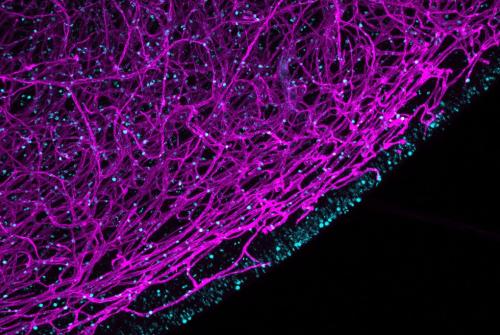 ‘Insights into Down’s syndrome brainstem’ was entered by Post-Doctoral Researcher Ekin Ucunco. This image shows blood vessels (pink) and proliferative cells (blue/green) in the hindbrain of a foetus with Down’s syndrome.
‘Insights into Down’s syndrome brainstem’ was entered by Post-Doctoral Researcher Ekin Ucunco. This image shows blood vessels (pink) and proliferative cells (blue/green) in the hindbrain of a foetus with Down’s syndrome. -
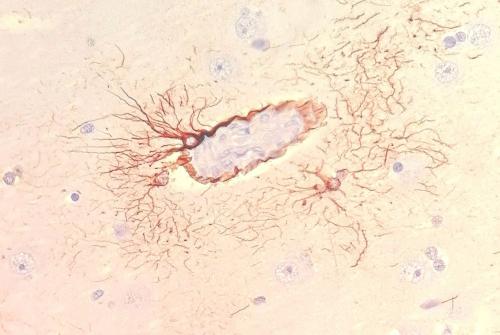 'Glial cells in action’ was entered by Allied Health Professional Lucien Bonfante. This image shows glial cells (brown), nerve helper cells, which have long fibre like structures that adhere to blood vessels and transport nutrients and oxygen to surrounding nerve cells.
'Glial cells in action’ was entered by Allied Health Professional Lucien Bonfante. This image shows glial cells (brown), nerve helper cells, which have long fibre like structures that adhere to blood vessels and transport nutrients and oxygen to surrounding nerve cells. -
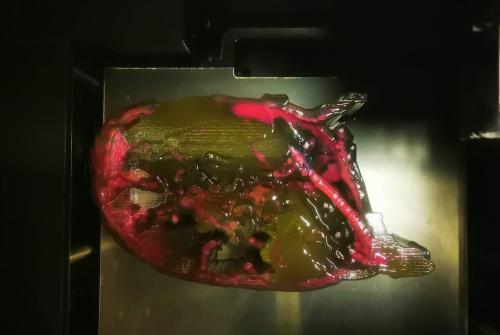 ‘3D modelling for safer neurosurgical planning’ was entered by 3D engineer Luke Smith. This giff shows a printhead moving left to right creating an accurate 3D printed model of a patient’s brain blood vessels.
‘3D modelling for safer neurosurgical planning’ was entered by 3D engineer Luke Smith. This giff shows a printhead moving left to right creating an accurate 3D printed model of a patient’s brain blood vessels.
Lasting impressions
It’s hard to believe that some of these images are of the human body!
Member of GOSH YPAG panel
Quite a few phantasmic pictures, the exploding gastric organoid is sublime! The image competition is a fantastic visual representation of the power of investing in children’s research.
Professor Thomas Voit, Director of NIHR GOSH UCL Biomedical Research Centre
A beautiful set of images which show the breadth of work across GOSH and its affiliated institutes, these images often represent the first stages of improving the lives of children at GOSH and around the world. It is a reminder of how research and innovation is incorporated into everything we do at GOSH.
Kiki Syrad, Director of Research and Innovation
Showcasing our research
In celebration of Rare Disease Day on the 29th of February, all the shortlisted images will be exhibited at a research event in the ZCR. The image display will then tour the hospital, showcasing the research connected to GOSH to as many people as possible.
